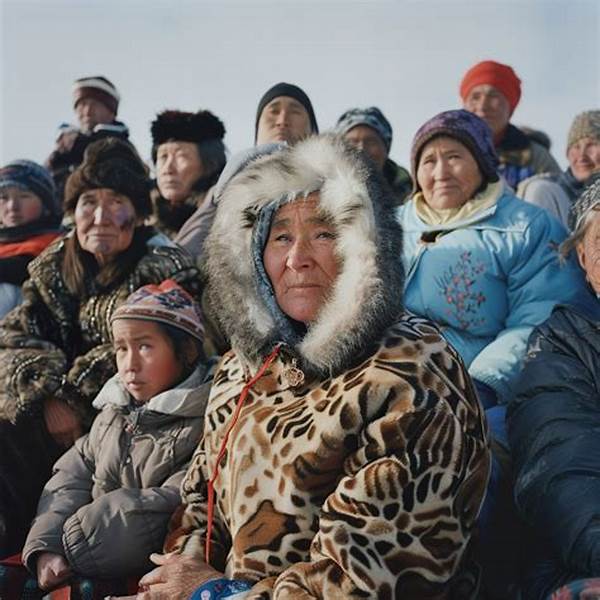The interaction between indigenous peoples and Arctic wildlife is an essential component of the broader environmental, cultural, and socio-economic nexus in the polar regions. Dwellers of the Arctic such as the Inuit, Sami, and Chukchi have long established a symbiotic relationship with the surrounding ecosystem. This relationship is characterized by sustainable practices that reflect respect for wildlife and a comprehensive understanding of ecological balance vital for survival in one of the world’s most challenging environments.
The Symbiotic Relationship
Indigenous peoples hold a profound knowledge of Arctic wildlife, a knowledge that has evolved over generations. They have developed a deep understanding of animal behavior, migratory patterns, and survival strategies, utilizing this information to sustain their communities. The cultural practices and traditions of these communities are intertwined with the natural world, influencing their spiritual beliefs and ceremonies. The wildlife not only serves as a fundamental source of food, clothing, and tools but also occupies a significant place in the folklore and mythologies of these communities. As a result, indigenous peoples play a crucial role in conserving Arctic wildlife, advocating for sustainable practices that can be adopted more broadly to combat the adverse effects of climate change and habitat loss.
Challenges Faced by Indigenous Communities
1. Climate Change Impacts: Indigenous peoples face profound challenges as climate change disrupts the Arctic environment, affecting wildlife patterns and causing ecological instability.
2. Loss of Biodiversity: The declining biodiversity poses a direct threat to the lifestyle and sustenance of indigenous communities relying on Arctic wildlife for survival.
3. Resource Exploitation: Industrial activities such as oil drilling and mining significantly alter habitats, impacting both indigenous peoples and Arctic wildlife.
4. Cultural Erosion: The erosion of cultural practices linked to wildlife due to modernization further isolates indigenous peoples from their heritage and traditional knowledge.
5. Legal and Policy Barriers: Restrictions and policies often overlook indigenous rights, making it difficult for these communities to manage the wildlife in their territories effectively.
Conservation Efforts and Indigenous Leadership
The traditional ecological knowledge possessed by indigenous peoples is integral to contemporary conservation efforts. By including indigenous perspectives in global environmental policies, a more holistic approach to managing the Arctic environment is achieved. Indigenous leaders actively participate in international forums, advocating for the rights of their communities and highlighting the importance of Arctic wildlife conservation. Their leadership in resource management offers insights into sustainable practices that have maintained biodiversity through centuries. As stewards of the Arctic, these communities champion initiatives that blend modern scientific approaches with traditional wisdom, ensuring the survival of Arctic wildlife and the continuity of their cultural heritage.
Economic and Social Interactions
The economies of indigenous peoples are heavily reliant on Arctic wildlife, which provides means of subsistence and cultural identity. Hunting, fishing, and trapping are not merely economic activities but are interwoven with the social fabric of these communities. The exchange of goods derived from wildlife fosters social cohesion and represents a link to ancestral traditions. However, shifts in wildlife populations due to climate change threaten these economic foundations and the social structures built upon them. Adaptive strategies are essential to mitigate these impacts, making collaborative efforts with governmental and non-governmental agencies pivotal in ensuring the resilience of indigenous economies.
Cultural Significance and Knowledge Transmission
Cultural narratives embedded within indigenous societies emphasize the harmonious relationship with Arctic wildlife. These stories and practices are not only integral to identity but also serve as educational tools transmitting environmental knowledge to future generations. Indigenous languages, often rich with ecological terminologies, further cement this connection. Preserving these languages is imperative for maintaining the ecological knowledge that underpins wildlife conservation. The collaboration between indigenous peoples and researchers facilitates cultural knowledge transmission, promoting biodiversity while safeguarding intangible cultural heritage.
Summary and Global Implications
The relationship between indigenous peoples and Arctic wildlife extends beyond local environments, presenting global implications for biodiversity and cultural diversity conservation. As climate change shows no signs of abating, the sustainability practices of indigenous communities offer valuable insights into adaptive strategies for broader ecological challenges. International cooperation and recognition of indigenous rights are essential in fostering innovative approaches to wildlife management and conservation. By aligning global policies with indigenous knowledge systems, a more sustainable future for the Arctic region and its inhabitants can be secured. The preservation of indigenous heritage and the protection of Arctic wildlife are inextricably linked, highlighting the necessity of integrative approaches in addressing the intricate challenges faced by these communities.





